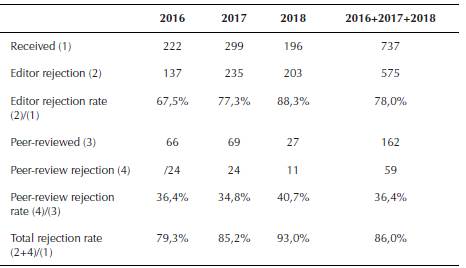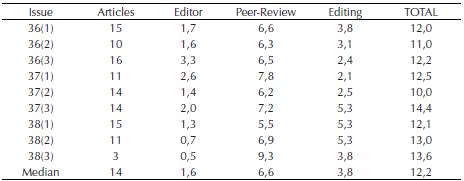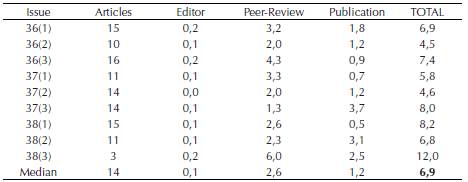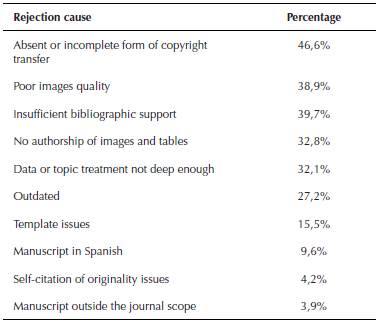Services on Demand
Journal
Article
Indicators
-
 Cited by SciELO
Cited by SciELO -
 Access statistics
Access statistics
Related links
-
 Cited by Google
Cited by Google -
 Similars in
SciELO
Similars in
SciELO -
 Similars in Google
Similars in Google
Share
Ingeniería e Investigación
Print version ISSN 0120-5609
Ing. Investig. vol.38 no.3 Bogotá Sep./Dec. 2018
Editorial
Editorial Management of Ingeniería e Investigación Journal
1 Director Revista Ingeniería e Investigación Profesor Asociado Departamento de Ingeniería Eléctrica y Electrónica Universidad Nacional de Colombia http://orcid.org/0000-0002-0971-0725
2 Editor Asociado Revista Ingeniería e Investigación, Profesor Titular, Departamento de Ingeniería Mecánica y Mecatrónica Universidad Nacional de Colombia. https://orcid.org/0000-0002-5004-113X
This editorial note presents a review of the publication times and the reasons for the rejection of manuscripts submitted for evaluation to Ingeniería e investigación Journal. Some adjustments have been made recently to the editorial policy of the journal that we consider important to share with authors and readers.
According to Palacios (2016), scientific journals are communication tools that must accomplish intertwined objectives: publish articles of high scientific quality, promote scientific cooperation, internationalize knowledge and stimulate academic discussion. As means of communication, journals must fulfill the needs of their community and must seek to address its interests. In recent editorial notes, we have reviewed the performance of the Ingeniería e Investigación Journal in terms of its comparative positioning results, using bibliometric performance indicators such as Cites per Document - CpD, References per Document - RpD and Documents per Journal a year -DpJ, as described in Pavas (2017), Pavas (2018a) and Pavas (2018b). On this occasion, we want to share results of the editorial team performance.
Management of manuscripts and reasons for rejection
First, let us take a look at the volume of manuscripts received. Table 1 shows the number of manuscripts received and the rejection rates between 2016 and 2018. Data is summarized up to November 30, 2018.
Table 1 Manuscripts received and rejection rates between 2016 and 2018

Source: Ingeniería e Investigación Files.
The Editorial Team has reviewed the causes of rejection of all the manuscripts summed in Table 1, which allowed us to present the highlights in Table 2. The causes of rejection after the peer-review are diverse and linked to the content of each article, thus Table 2 shows only the reasons for rejection after the review of the Editor. In most cases, manuscripts are rejected due to combinations of various causes.
Regarding the reasons for rejection of the editor, it is pertinent to make some recommendations on topics that we consider sensitive and worth highlighting. For reviewing the topics that are not described in detail, we invite readers and authors to check the editorial policy of the Journal and the guidelines for authors.
The letter of copyright transfer gives Ingeniería e Investigación Journal and Universidad Nacional de Colombia the faculties to spread the content of the manuscript that overcome the peer-review process. It is necessary to fill ali the required information, including the data of all authors without exception. We recommend that each author create and make public their profile in Google Scholar and ORCID to facilitate their identification and favor their visibility. Recently, we have made an adjustment to the letter of copyright transfer, so that authors hold the rights on their contents, in addition to authorize the manuscript release through a Creative Commons License of Attribution (CC-BY). This is aligned with good editorial practices and open access, which is a policy supported and promoted by the Ingeniería e Investigación Journal as a way to share and disseminate knowledge.
As presented in previous editorial letters (Pavas, 2018a), the scientific publications that share indexation with Ingeniería e Investigación in the databases have different performance indicators. We use these results as a recommendation for the authors to make a sufficient bibliographic review in order to explore precise, pertinent and current scientific references. We also recommend that all authors search as much as possible for references published in Colombia and in the Latin American region, though it is not a mandatory requirement. Ingeniería e Investigación Journal respects the autonomy of authors when selecting works published on different dates, but in order to offer contents of high relevance and pertinence for the readers, we suggest that the references are preferably from scientific publications of the last eight (8) years. Additionally, we consider that the works published previously by the authors offer a testimony of their experience and perspective on the subject; however, a high number of self-citations is questionable in terms of transparency and objectivity.
The Journal Ingeniería e Investigación aims to maintain high quality standards, so that readers find material of interest, updated and with a rigorous treatment of the topics. As a suggestion regarding the rigor of the articles, we have the following general recommendations:
Articles should develop an updated and wide-ranging review of the topic, including as much as possible references from the Colombian and Latin American context. The article should identify precisely the topic and the problem addressed in the article, highlighting its relevance and possible application.
Support information to solve the problem should be treated clearly, objectively and in detail. Data can come from experimental tests, simulations, field data, databases, etc. The treatment of support information should be accompanied by a detailed analysis based on quantitative and qualitative analysis tools relevant to the subject.
Authors should emphasize the contribution of their work to knowledge on the topic of the article.
The Universidad Nacional de Colombia uses Turnitin computer tool to evaluate the originality of the manuscripts submitted for publication. The results of the evaluation of originality made by Turnitin are used informatively to review a manuscript. When it is rejected for originality, we invite the authors to make adjustments to their manuscript. We consider that the use of these tools helps editorial teams to identify aspects to be improved in the content of the manuscripts, but also to offer original and novel material to readers.
Publication Times
Now, we will show the recent publication times of the Ingeniería e Investigación Journal. Data of the last three years are related. Table 3 shows five aspects related to the publication times: the number of articles published, the editor's review times, the peer-review times, the editing times (proofreading, layout, confirmation by authors and publication in OJS) and the total publication time. From Table 3, it can be observed that the most sensitive work is the peer-review, whose median is 6.6 months.
Table 3 Average publication times in months for every issue between 2016 y 2018 (Data up to November 30, 2018).

Source: Ingeniería e Investigación Files.
As complementary information, we consider it relevant to show the minimum publication times, which are listed in Table 4.
Table 4 Minimum publication times in months for every issue between 2016 and 2018 (Data up to November 30, 2018).

Source: Ingeniería e Investigación Files.
Table 4 confirms that even in cases when rapid publication has been achieved, peer-review remains the most sensitive component. In order to improve the publication times of the Ingeniería e Investigación Journal, the Editorial Team has implemented the following management actions:
Maintain editor review times below one month. The goal is to reduce it to a maximum of two (2) weeks. The Journal advances in engaging Associated Editors to assist in this purpose.
From number 38(3), the Magazine began continuous publication. This means that each article that successfully completes the evaluation process will be published in-press, with its complete identification, except for the pagination. We consider important to clarify that the DOI assigned to the article published in-press will be the same for the final article. The final articles will be published on the dates declared in the periodicity of the Journal (April, August and December). As a result of this adjustment, we hope that the total publication time will be reduced between one and four months.
Since 2016, we have made a record and continuous monitoring of the editorial effort made in the management of peer reviewers. Ingeniería e Investigación is committed to an open access policy following the golden route. We do not charge for publishing or accessing content, thus the option to pay for review is not among our plans. Based on the discussion and exchange of information with journals similar to Ingeniería e Investigación, our peer-review times do not differ significantly from them. We are managing the search for peers and the recognition of peer-review through the means available at the Universidad Nacional de Colombia. One of them is the Publons profile portal, from Clarivate Analytics. Through the indexing of Ingeniería e Investigación in Web of Science, reviewers receive credit for their revisions, which improves their visibility and prestige.
Finally, we also take this opportunity to share with our readers that Professor Nelson Arzola de la Peña has joined the team as Associate Editor, we trust that his participation will be very useful to improve Ingeniería e Investigación Journal.
Once again, we appreciate the confidence placed by authors and readers in this Journal.
Referencias
Palacios, Mauricio. (2016). ¿Cuál es el objetivo de una revista científica?. Ingeniería y competitividad, 18(2), 8-10. https://doi.org/10.25100/iyc.v18i2.2148 [ Links ]
Pavas, Andrés (2017). Are there chances of improving Colombian engineering journals rankings? Ingeniería e Investigación, 37(3), 3-7, https://doi.org/10.15446/ing.investig.v37n3.69519 [ Links ]
Pavas, Andrés (2018a). What are the differences between engineering journal performances? Ingeniería e Investigación, 38(1) 3-7, https://doi.org/10.15446/ing.investig.v38n1.71250 [ Links ]
Pavas, Andrés (2018b). Novelties in the 2017 SJR for Engineering journals ranking. Ingeniería e Investigación, 38(2) 3-8, https://doi.org/10.15446/ing.investig.v38n2.73400. [ Links ]











 text in
text in 



